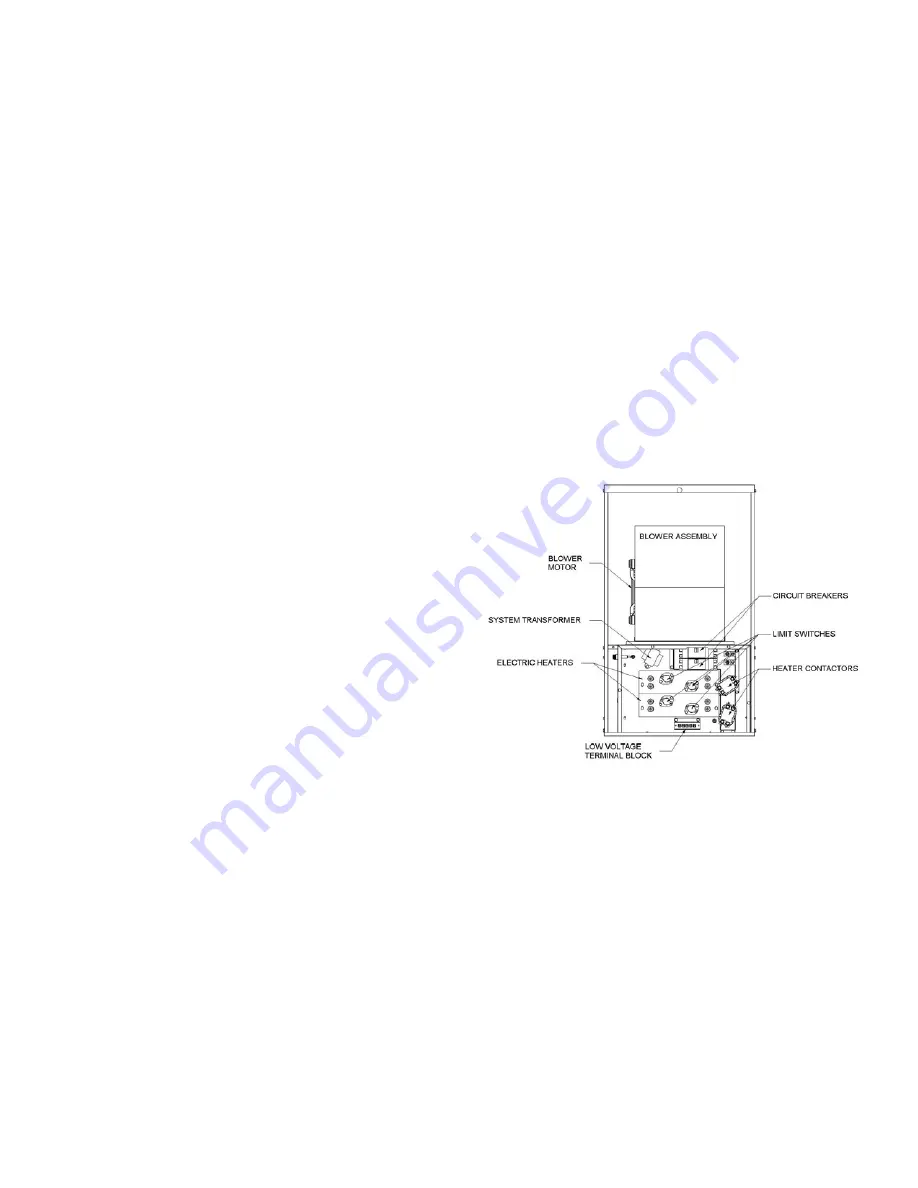
MORTEX
PRODUCTS
INC
FORT
WORTH,
TX
76106
Page
9
15.
Reinstall the blower assembly and secure the assembly
using the screws that were removed in step 5.
16.
Reinstall the control box cover and secure it to the control
box with the screws that were removed in step 4.
17.
Reinstall the lower access door on the furnace.
18.
Reinstall the upper access door on the front of the
evaporator coil compartment.
19.
Follow the instructions exactly as shown in start Up and
Shutdown Section in this manual to properly start Up this
appliance.
SECTION III: FURNACE CONTROLS
This section discusses the furnace controls and how they
operate. Refer to Figure 9 for component locations.
1.
The Limit Controls
– Each electric heater element has a
limit control directly in front of it to sense overheating of
the element and opens if the temperature gets above the
set point of the limit control.
2.
The Heater Contactors
– The electric heater contactors
simply turn the heater elements on and off. The contactors
are controlled by the thermostat. On a call for heat 24
VAC is sent to the contactor 24 VAC coil energizing the
contactor. When the call for heat has been satisfied the 24
VAC is removed from the contactors 24 VAC coil de-
energizing the contactors.
3.
Cooling Time Delay
– The cooling indoor fan on / off
delay is factory programmed in the indoor fan motor
software and is non-adjustable.
4.
Heating Time Delay
– The heating indoor fan on / off
delay is factory programmed in the indoor fan motor
software and is non-adjustable.
5.
Circuit breakers
– The circuit breakers are designed as
over-current protection for the electric heaters only. The
circuit breakers MUST NEVER be used for over-current
protection for the transformer, 24 VAC circuit, or the
blower motor.
6.
3 Amp Fuse
– This fuse is used for over-current
protection of the 24 VAC circuit.
7.
Transformer
– The transformer is used to step down
voltage from 240 VAC to 24 VAC. The transformer
provides the required 24 VAC for the system control
circuit.
8.
Thermostat “G” Circuit
– The thermostat “G” circuit is
used for constant circulation only. When 24 VAC is
placed on the thermostat “G” circuit the 24 vac is sent to
the indoor fan motor where it will operate around 200
CFM. This is not enough air flow for heating or cooling
operation.
9.
Thermostat “Y” Circuit
– The thermostat “Y” circuit is
used for cooling or high speed indoor fan operation.
When 24 VAC is placed on the thermostat “Y” circuit the
24 vac is sent to the indoor fan motor where it will
operate around at high speed. The compressor contactor is
also connected to this terminal.
10.
Thermostat “W” Circuit
– The thermostat “W” circuit is
used for the heating indoor fan blower operation on the
Med-low or Medium speed. When 24 VAC is placed on
the thermostat “W” circuit the 24 vac is sent to the indoor
fan motor where it will operate at the selected speed
required for heating after the ON delay has been
completed.
SECTION IV: SEQUENCE OF OPERATION
Continuous Blower
The thermostat has a manual fan switch that can be moved to
the “
On”
position or it can be programmed for
continuous
fan
operation. This setting causes the thermostat to complete the
circuit between “R” and “G” terminals causing the blower
motor to start the ON time delay. Once the time delay has
completed the motor will start. When the thermostat “G”
circuit has been de-energized the motor will start the OFF
delay. The motor will turn off when the off delay has been
completed.
The indoor blower will operate continuously until the fan
switch on the thermostat has been switched from ON to
AUTO. The AUTO position will allow the blower motor to
operate only when there is a call for heat or cooling. The
motor will remain in standby mode at all other times.
Figure 9: Component Locations
Intermittent Blower - Cooling
The thermostat has a manual fan switch that can be moved to
the “
Auto”
position or it can be programmed for
auto
fan
operation. When the thermostat calls for cooling, a circuit is
completed between the “R” and “Y” Terminals. The indoor
fan motor is energized from the “Y” terminal on the
thermostat causing the indoor fan motor to start after the ON
delay has expired. The motor will start on the selected speed
tap that is connected to the “Y” terminal. When the call for
cooling is complete the blower motor will start the off delay.
Once the off delay has expired the motor will de-energize.
The blower is now in the standby mode waiting for the next
cooling cycle
The Heating Cycle
When the thermostat is in the HEAT mode and the fan switch
on the thermostat is set to AUTO. The call for heat closes the
thermostat circuit between the “R” and “W” terminals. 24
VAC is sent from the “W” thermostat terminal, through the





































